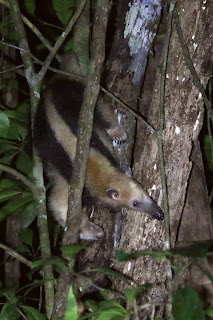The previous evening we had agreed to an early start to try and check an area behind the camp for the Amazonian Barred Woodcreeper, one of the reserve's rarest inhabitants. Sadly we failed to get anything for our efforts. Upon return to the camp, the adjacent fruiting trees were very lively and there was a cracking male Green Honeycreeper, which is a rare bird for the site. There was also a very nice male Yellow-backed Tanager, which is just the second time I have seen this species.
We spent
the day in a new area looking for nests. Helpfully it was not far from the main
trail but the terrain was hard work. Birdlife was limited, although the endemic
trogon eluded us once again, calling distantly in the forest but going silent
once we approached. There were a few birds to see, but most were common species
such as the Red-headed Manakin, of which we were able to locate an active nest
with two chicks, and a White-bellied Tody-Tyrant.
On our way
back we found an ant swarm crossing the trail, the first one I have seen here.
There was not a great deal of diversity in the bird species following it, but
it was excellent to watch the East Amazonian Fire-Eye as they fed. This swarm
was still here when we headed out later in the early evening, and in addition
to the Fire-Eye we managed to find two of the Amazonian Barred Woodcreeper. The
birds called from deep in the forest, but with some playback they came,
allowing us to get a photo of this rare resident.
Our evening
expedition was to a small river at the far end of the reserve which was home to
a few frog species, some of which are highly endemic to Murici. Before that, however, we wanted to stop at a site on the border where we would be able to get
fantastic views of the forest at sunset. The views were fantastic and we were
able to enjoy a stunning orange sky while the time passed. It was dark when we
left this open area, and night birds had already begun to appear, including two
Pauraque and a Rufous Nightjar, although the latter we did not identify until
the next day when analyzing photos. This was something of a shame, as its only
the second time I’ve ever observed this bird, and the first time I have seen it
properly.
Our night
in the forest was excellent, and that is an understatement. On our way down to
the river, Herminio picked out a Pernambuco Dwarf Porcupine Coendou speratus
sitting high in the canopy. This is the other species to occur at the reserve,
the rarer and endemic species, and we were very lucky to see it. Then the frogs
were fantastic, with more than five species at least, including all of the
specificalities; Scinax muriciensis, Crossodactylus dantei and Boana
freicaneca, two of which occur only in this reserve. Then, to really put
the icing on the cake, we spotted a Kinkajou on our way back, which was moving
high through the canopy, but frustratingly only showing occasionally.
But then,
it really climaxed when we stopped for some signal. Although it was quite late,
we stopped at the location for the internet, while Lia headed straight back to the
camp. We had been there less than five minutes when Herminio spotted an
absolutely incredible Southern Tamandua feeding in a rotting tree next to us.
The animal was completely unfussed by our presence as it used its claws to rip
into the branches while hanging on with its prehensile tail. After I had run
off to collect Lia, we were able to watch it feeding for a good ten minutes
before it slowly ambled up the trunk and into the canopy. Even after all the
mammals, we have had the privilege of seeing in this reserve, this really was
something else.
ESEC Murici: Short-tailed Nighthawk, Pauraque, Rufous Nightjar, Black Jacobin, Reddish Hermit, Black Hawk-Eagle, Black-throated Trogon, Crested Caracara, Yellow-headed Caracara, Laughing Falcon, Chestnut-backed Antshrike, White-shouldered Antshrike, Plain Antvireo, Silvery-flanked Antwren, Rusty-winged Antwren, East Amazonian Fire-eye, Scalloped Antbird, Black-cheeked Gnateater, Plain-winged Woodcreeper, Amazonian Barred Woodcreeper, Ceara Woodcreeper, Blue-backed Manakin, Red-headed Manakin, Screaming Piha, Brown-winged Schiffornis, White-throated Spadebill, Ochre-bellied Flycatcher, Sepia-capped Flycatcher, White-bellied Tody-Tyrant, Ochre-lored Flatbill, Yellow-bellied Elaenia, Planalto Tyrannulet, Greyish Mourner, Great Kiskadee, Tropical Kingbird, Trilling Gnatwren, Moustached Wren, Pale-breasted Thrush, Violaceous Euphonia, Yellow-green Grosbeak, Flame-crested Tanager, Palm Tanager, Red-legged Honeycreeper, Green Honeycreeper, Yellow-backed Tanager, Bananaquit, Kinkajou, Pernambuco Dwarf Porcupine, Southern Tamandua,

















No comments:
Post a Comment